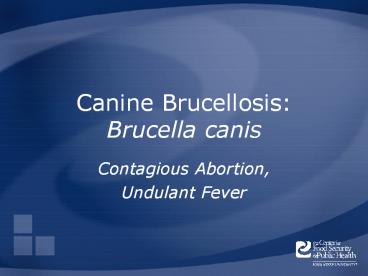Canine Brucellosis: Brucella canis - PowerPoint PPT Presentation
Title:
Canine Brucellosis: Brucella canis
Description:
Canine Brucellosis: Brucella canis Contagious Abortion, Undulant Fever B. canis occurs in the fetus, placenta, fetal fluids and vaginal discharge after an abortion or ... – PowerPoint PPT presentation
Number of Views:809
Avg rating:3.0/5.0
Title: Canine Brucellosis: Brucella canis
1
Canine BrucellosisBrucella canis
- Contagious Abortion,
- Undulant Fever
2
Overview
- Organism
- History
- Epidemiology
- Transmission
- Disease in Humans
- Disease in Animals
- Prevention and Control
- Actions to Take
3
The Organism
4
The Organism
- Brucella canis
- Gram negative coccobacillus
- Facultative intracellular pathogen
- Other Brucella speciesthat can affect dogs
- B. abortus, B. melitensis, B. suis
- Can persist in the environment
5
The Many Names of Brucellosis
- Human Disease
- Malta Fever
- Undulant Fever
- Mediterranean Fever
- Rock Fever of Gibraltar
- Gastric Fever
- Animal Disease
- Bangs Disease
- Enzootic Abortion
- Epizootic Abortion
- Slinking of Calves
- Ram Epididymitis
- Contagious Abortion
6
History
7
History of Brucellosis
- Early 1800s
- Sir William Burnett differentiates fevers
affecting seamen in the Mediterranean - Late 1880s
- Sir David Bruce isolates the cause of Malta
fever, Micrococcus melitensis - Dr. Bernhard Band discovers cause of cattle
abortion in Denmark, Bacterium abortus
(Bangs disease)
8
History of Brucella canis
- First isolated in 1966
- Dogs, caribou, and reindeer
- Now knownto be animportantcause ofeconomic
lossin kennels
9
Epidemiology
10
Geographic Distribution
- United States
- Canada
- Central and South America
- Some European countries
- Parts of Africa and Asia
- Free areas
- Australia, New Zealand
11
Species Affected
- Mainly dogs
- Experimental infection
- Domestic livestock
- Chimpanzees
- Humans
- Laboratory workers
- People in close contact with dogs
12
Transmission
13
Transmission in Humans
- Ingestion
- Contamination of mucous membranes and abraded
skin - Close contact required
- Infected dogs
- Bacterial cultures
14
Transmission in Animals
- Contact with fetus/fetal membrane
- Ingestion
- Mucous membranes
- Broken skin
- Venereal
- In utero
- Milk
- Fomites
15
Disease in Humans
16
Disease in Humans
- May be asymptomatic
- If symptomatic
- Disease is variable
- Often begins as acute febrile illness with
influenza-like signs - Spontaneous recovery possible
- Disease may wax and wane
17
Treatment and Prognosis in Humans
- Possible complications
- Arthritis, spondylitis, chronic fatigue,
epididymo-orchitis - Neurologic signs
- Treatment with antibiotics
- Relapses possible
- Low mortality
- 2 to 5 (untreated cases)
- Death from endocarditis, meningitis
18
Disease in Animals
19
Clinical Signs
- Incubation period 2 to 3 weeks
- Pregnant dogs
- Late-term abortion, stillbirths
- Vaginal discharge
- Weak pups that die soon after birth
- Males
- Abnormal sperm
- Epididymitis, scrotal edema, orchitis
20
Clinical Signs
- Lymphadenitis
- Other general signs
- Lethargy
- Decreased appetite
- Behavioral abnormalities
- Stiffness, lameness, or back pain
- Many dogs asymptomatic
- Chronic infections possible
21
Postmortem Lesions
- Lymph node enlargement
- Retropharyngeal, inguinal, generalized
lymphadenitis - Splenomegaly
- Hepatomegaly
- Scrotal dermatitis, epididymitis
22
Morbidity and Mortality
- All dogs susceptible
- Prevalence unclear
- Up to 30 reported in S., Central America
- Up to 6 in Southern U.S.
- Most common in stray/feral dogs
- Death is rare
- Fetus, neonate most affected
- May cause significant reproductive losses in
breeding kennels
23
Differential Diagnosis
- Beta-hemolytic streptococci
- Escherichia coli
- Mycoplasma, Ureaplasma
- Streptomyces
- Salmonella, Campylobacter
- Canine herpesvirus
- Neospora caninum
- Toxoplasma gondii
24
Laboratory Diagnosis
- Serology
- Rapid slide agglutination, indirect fluorescent
antibody, AGID, ELISA - Cross-reactions may occur
- Other Brucella spp., Gram negatives
- Culture and identification
- Definitive diagnosis
- PCR
25
Prevention and Control
26
Recommended Actions
- Notification of authorities
- Federal
- Area Veterinarian in Charge (AVIC)
- http//www.aphis.usda.gov/animal_health/area_offi
ces/ - State
- State Animal Health Officials (SAHO)
- www.usaha.org/Portals/6/StateAnimalHealthOfficials
.pdf
27
Prevention and Control
- Kennels and breeding programs
- Remove infected dogs
- Individual caging
- Repeated testing
- No vaccine
- Antibiotics
- May be useful
- Neuter
28
Prevention and Control
- Education about risk of transmission
- Veterinarians, animal husbandry clubs, laboratory
workers, and dog breeders - Wear proper attire if dealing with infected
animals/tissues - Gloves, masks, goggles
29
Prevention and Control
- Readily killed by most disinfectants
- Hypochlorite
- 70 ethanol
- Isopropanol
- Iodophores
- Phenolics
- Formaldehyde/glutaraldehyde
- Quaternary ammonium compounds not recommended
30
Additional Resources
- Center for Food Security and Public Health
- www.cfsph.iastate.edu
- Centers for Disease Control and Prevention (CDC)
Brucellosis - http//www.cdc.gov/ncidod/dbmd/diseaseinfo/brucell
osis_g.htm
31
Acknowledgments
- Development of this presentation was made
possible through grants provided to the Center
for Food Security and Public Health at Iowa State
University, College of Veterinary Medicine from - the Centers for Disease Control and Prevention,
the U.S. Department of Agriculture, the Iowa
Homeland Security and Emergency Management
Division, and the Multi-State Partnership for
Security in Agriculture. - Authors Kerry Leedom Larson, DVM, MPH, PhD,
DACVPM Anna Rovid Spickler, DVM, PhD Sarah
Viera, MPHReviewer Glenda Dvorak, DVM, MPH,
DACVPM

